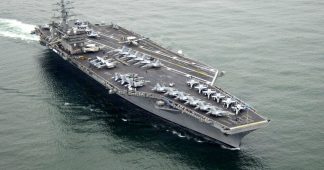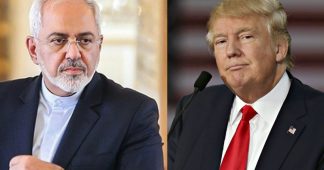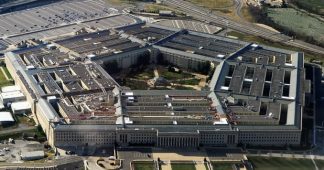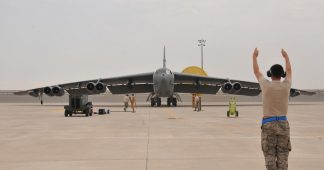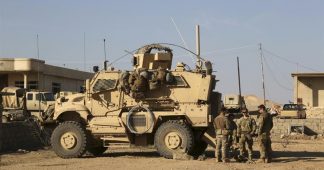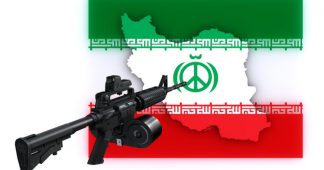President Donald Trump was behind the abrupt decision announced on Sunday night to reverse course and keep the aircraft carrier USS Nimitz in the Middle East due to Iranian threats against top U.S. officials, according to two people familiar with the discussions.
The move was the latest in a string of reversals that befuddled observers and sent mixed signals to Iran.
The Pentagon, alarmed by increased Iranian activity ahead of the one-year anniversary of the death of Iranian leader Qasem Soleimani, has in recent weeks taken action to shore up its forces in the Middle East and signal that the U.S. will respond to any attack. So Iran watchers were surprised on Thursday when acting Defense Secretary Chris Miller ordered the Nimitz, which had been on station in the Middle East, to return home.
Miller made the move over the objections of top commanders, a development first reported by The New York Times and confirmed by a defense official. He announced he was sending the carrier home as a “de-escalation” tactic as tensions with Tehran continued to simmer. But the ship was also scheduled to return around that time for routine maintenance anyway, and the Navy had pushed for the departure, officials said.
After public threats from Iranian leaders over the weekend, Trump abruptly ordered Miller to turn the carrier around and keep it in the Middle East, according to two U.S. officials, who spoke on condition of anonymity to discuss internal deliberations. CNN first reported that Trump gave the order.
The White House and the Pentagon declined to comment.
Miller said in the new statement on Sunday that the reversal was due to “recent threats issued by Iranian leaders against President Trump and other US government officials.” But one senior defense official said there had been no change in the threat level leading up to the decision.
“The USS Nimitz will now remain on station in the US Central Command area of operations,” Miller said. “No one should doubt the resolve of the United States of America.”
The reversal came after the head of Iran’s judiciary, Ebrahim Raisi, seemed to implicitly threaten Trump on Friday, saying that all those who had a role in Soleimani’s killing would not be able to “escape law and justice” — even if they were a U.S. president.
And on Saturday, Iranian Foreign Minister Mohammad Javad Zarif cited “new intelligence” from Iraq indicating that “Israeli agent-provocateurs” are plotting attacks against Americans, which some took as a preemptive effort to deflect blame for any attack.
“Be careful of a trap, @realDonaldTrump,” Zarif tweeted. “Any fireworks will backfire badly, particularly against your same BFFs.”
Some former defense officials criticized the latest reversal, noting that the mixed messaging increases the risk of a miscalculation that could lead to conflict.
“When you already have a volatile situation, a tension between two powers with large military formations, the risk of miscalculation is higher,” said Dave Lapan, retired Marine colonel who served as DoD and Department of Homeland Security spokesperson. “It’s hard to see what the strategy is.”
Lapan also expressed concern for the Nimitz sailors and their families, who were told they were headed home only to be abruptly sent back again.
In recent weeks, the Pentagon has sent B-52 bombers over the Persian Gulf as a signal to deter an Iranian attack. Late last month, the military also sent a guided-missile submarine on an unusual transit through the Strait of Hormuz, and an additional fighter squadron to the region. The military also published photos and videos of the flights and transits as a message to Iran.
The U.S. is reducing its troop level in Iraq from 3,000 to about 2,500 on Trump’s orders.
The deployments to the region reflect growing concern that Iran will take additional military action in response for the Jan. 3, 2020, killing of Soleimani. Tehran’s initial response, five days later, was a ballistic missile attack on Iraq’s Camp Taji base, which caused concussion-like injuries to about 100 U.S. troops.
Even after the anniversary passed on Sunday, the Pentagon is still on high alert for an attack from Iran on U.S. or allied forces in the Middle East, according to one of the officials. Adding to the tension was a Dec. 20 rocket attack on the U.S. embassy in Baghdad by Iranian-backed Shiite militia groups, which caused no casualties. Days later, Trump blamed Iran for the attack and put Tehran on notice.
“Some friendly health advice to Iran: If one American is killed, I will hold Iran responsible. Think it over,” Trump wrote on Twitter.
Published at www.politico.com
